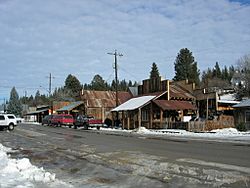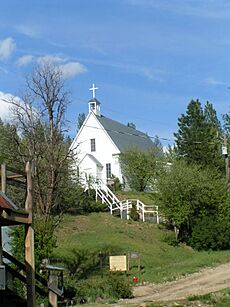Idaho City, Idaho facts for kids
Quick facts for kids
Idaho City, Idaho
|
|
|---|---|

Streetside in Idaho City in 2005
|
|

Location of Idaho City in Boise County, Idaho.
|
|
| Country | United States |
| State | Idaho |
| County | Boise |
| Area | |
| • Total | 0.67 sq mi (1.73 km2) |
| • Land | 0.67 sq mi (1.72 km2) |
| • Water | 0.00 sq mi (0.00 km2) |
| Elevation | 3,986 ft (1,215 m) |
| Population
(2020)
|
|
| • Total | 466 |
| • Density | 702.26/sq mi (271.13/km2) |
| Time zone | UTC-7 (Mountain (MST)) |
| • Summer (DST) | UTC-6 (MDT) |
| ZIP code |
83631
|
| Area code(s) | 208, 986 |
| FIPS code | 16-39610 |
| GNIS feature ID | 2410090 |
Idaho City is a small town in Boise County, Idaho, United States. It is the main town, or county seat, of Boise County. The town is located about 36 miles (58 km) northeast of Boise. In 2020, 466 people lived there.
Idaho City is part of the larger Boise City−Nampa area, which is a big group of connected towns and cities.
Contents
History of Idaho City
Idaho City was started in December 1862. It was first called “Bannock” or “West Bannock.” This happened during the exciting Boise Basin gold rush, which was the biggest gold rush since the one in California many years before.
The town was built near where Elk and Mores Creeks meet. This spot had plenty of water, which helped it grow faster than other nearby mining camps like Placerville. As more people moved in, the new Idaho Territory government changed the town’s name to “Idaho City.” This was to avoid confusion with another town called Bannack in Montana.
Idaho City's Gold Rush Peak
In the mid-1860s, Idaho City was very busy. It had over 200 businesses, including many saloons and law offices. In 1864, about 7,000 people lived there. This made it the largest city in the Pacific Northwest, even bigger than Portland at the time!
Buildings were mostly made of wood, which led to many fires. Idaho City burned down four times: in 1865, 1867, 1868, and 1871. More recently, five businesses on Main Street burned in June 2015.
Early Buildings and Groups
In 1863, St. Joseph’s Catholic Church was started. It was the first Catholic church in the new Idaho Territory. The church building was finished the next year.
Idaho City is also important for a group called the Masons. The Grand Lodge of Idaho, which is a main group for Masons in Idaho, was founded in Idaho City in 1867.
Life After the Gold Rush
During the gold rush, many thousands of people lived in the Boise Basin area. But most people left the mountains when gold mining slowed down. Idaho City’s population dropped to under 900 by 1870 and was only 104 by 1920.
Today, Idaho City’s economy mostly relies on people visiting for hunting and fishing. Many visitors also come to see the historic sites, like the Boot Hill Cemetery. You can still see old mining tailings (piles of waste rock) outside of town.
Political Connections
Senator Frank Church announced he would run for president from the county courthouse in Idaho City in March 1976. His grandfather had moved there in 1871, and his father was born there in 1889. Frank Church’s father-in-law, Chase Clark, also announced his run for governor in Idaho City in 1940.
Chinese Immigrants in Idaho City
Between 1869 and 1875, about four thousand Chinese people lived in the Idaho Territory. Like many Chinese immigrants, they came to America, which they called “Gold Mountain,” to work as miners. Some also worked as laundrymen or cooks.
The store of Pon Yam, an important Chinese businessman, is one of the few buildings left from Idaho City’s Chinese community. In 1870, almost half of Idaho City’s residents were Chinese. Today, you mostly see Chinese people as tourists.
A famous woman from Idaho City was Annie Lee. She escaped from a difficult situation in the 1870s. She went to Boise to marry a Chinese man she loved. Her former owner accused her of stealing, but she told a judge she wanted to stay in Boise. The judge then gave her freedom.
Geography and Climate
Idaho City is located at 43°49′43″N 115°49′56″W / 43.82861°N 115.83222°W. It is about 3,907 feet (1,191 meters) above sea level.
The United States Census Bureau says the city covers about 0.67 square miles (1.73 square kilometers). All of this area is land.
Idaho City's Weather
Idaho City has a typical continental climate for the Inland Northwest. This means it has cold, snowy winters and warm, dry summers. The temperatures can change a lot between day and night.
The town has about 217 nights a year where the temperature drops below 32°F (0°C). This is as many as Fairbanks, Alaska! It also has 24 days a year where the temperature stays below freezing. About 14 nights drop below 0°F (-18°C).
Idaho City gets much more rain and snow than nearby Boise. It gets twice as much rain and almost four times as much snow. On average, it gets 71.6 inches (182 cm) of snow each year. The most snow on the ground at one time was 46 inches (1.17 meters) in January 1982.
| Climate data for Idaho City, Idaho (1971–2000) | |||||||||||||
|---|---|---|---|---|---|---|---|---|---|---|---|---|---|
| Month | Jan | Feb | Mar | Apr | May | Jun | Jul | Aug | Sep | Oct | Nov | Dec | Year |
| Record high °F (°C) | 56 (13) |
65 (18) |
76 (24) |
88 (31) |
95 (35) |
106 (41) |
109 (43) |
106 (41) |
100 (38) |
91 (33) |
75 (24) |
64 (18) |
109 (43) |
| Mean daily maximum °F (°C) | 34.9 (1.6) |
41.0 (5.0) |
48.0 (8.9) |
57.3 (14.1) |
66.8 (19.3) |
76.1 (24.5) |
85.8 (29.9) |
85.6 (29.8) |
75.4 (24.1) |
62.8 (17.1) |
43.8 (6.6) |
34.8 (1.6) |
59.4 (15.2) |
| Mean daily minimum °F (°C) | 12.2 (−11.0) |
15.0 (−9.4) |
21.9 (−5.6) |
27.6 (−2.4) |
34.6 (1.4) |
40.2 (4.6) |
44.4 (6.9) |
43.0 (6.1) |
34.8 (1.6) |
26.8 (−2.9) |
20.4 (−6.4) |
12.6 (−10.8) |
27.8 (−2.3) |
| Record low °F (°C) | −38 (−39) |
−35 (−37) |
−20 (−29) |
−8 (−22) |
17 (−8) |
24 (−4) |
26 (−3) |
24 (−4) |
11 (−12) |
2 (−17) |
−18 (−28) |
−32 (−36) |
−38 (−39) |
| Average precipitation inches (mm) | 3.44 (87) |
2.77 (70) |
2.44 (62) |
1.87 (47) |
1.88 (48) |
1.33 (34) |
0.67 (17) |
0.51 (13) |
1.16 (29) |
1.45 (37) |
3.08 (78) |
3.51 (89) |
24.11 (611) |
| Average snowfall inches (cm) | 21.6 (55) |
12.1 (31) |
4.2 (11) |
1.2 (3.0) |
0.1 (0.25) |
0.0 (0.0) |
0.0 (0.0) |
0.0 (0.0) |
0.0 (0.0) |
1.0 (2.5) |
12.3 (31) |
19.0 (48) |
71.5 (181.75) |
| Average precipitation days (≥ 0.01 inch) | 11.1 | 10.6 | 10.6 | 8.8 | 8.6 | 6.0 | 3.1 | 2.7 | 4.0 | 5.8 | 11.5 | 12.0 | 94.8 |
| Average snowy days (≥ 0.1 inch) | 7.1 | 4.9 | 2.0 | 0.4 | 0.0 | 0.0 | 0.0 | 0.0 | 0.0 | 0.0 | 3.7 | 7.2 | 25.3 |
| Source: NOAA (normals, 1971–2000) | |||||||||||||
People of Idaho City (Demographics)
| Historical population | |||
|---|---|---|---|
| Census | Pop. | %± | |
| 1880 | 672 | — | |
| 1900 | 390 | — | |
| 1910 | 262 | −32.8% | |
| 1920 | 104 | −60.3% | |
| 1930 | 187 | 79.8% | |
| 1940 | 273 | 46.0% | |
| 1950 | 246 | −9.9% | |
| 1960 | 188 | −23.6% | |
| 1970 | 164 | −12.8% | |
| 1980 | 300 | 82.9% | |
| 1990 | 322 | 7.3% | |
| 2000 | 458 | 42.2% | |
| 2010 | 485 | 5.9% | |
| 2020 | 466 | −3.9% | |
| U.S. Decennial Census | |||
2020 Census Information
In 2020, there were 466 people living in Idaho City. There were 319 households (groups of people living together) and 226 families. About 267 homes were in the city.
Most people (84.33%) were White. Other groups included Native American (2.57%), Asian (0.85%), and African American (0.85%). About 5.79% of the population was Hispanic or Latino.
About 29.18% of households had children under 18 living with them. Most households (58.9%) were married couples. About 22.9% of households were single people living alone. The average household had 2.10 people.
The average age in Idaho City was 38.3 years. About 26.44% of residents were under 18. About 20.65% were 65 years or older. For every 100 females, there were about 84.9 males.
The average income for a household was $42,361. For families, it was $53,967. About 6.8% of the people lived below the poverty line.
2010 Census Information
In 2010, there were 485 people living in Idaho City. There were 216 households and 124 families. The city had about 723.9 people per square mile (279.5 people per square kilometer).
Most people (94.2%) were White. Other groups included Native American (1.6%) and Asian (0.8%). About 4.9% of the population was Hispanic or Latino.
About 28.2% of households had children under 18. About 43.5% were married couples. Many households (37.0%) were single people living alone. The average household had 2.25 people.
The average age in the city was 42.2 years. About 23.9% of residents were under 18. About 13% were 65 years or older. The population was 51.1% male and 48.9% female.
Population History
- 1863: 6,275 people
- 1864: 7,000 people
Transportation
The town is served by State Highway 21. This is a two-lane road that connects Idaho City to Boise in the southwest. To the northeast, it goes to Lowman and Stanley.
The highway goes through the Boise National Forest. It is known as the “Ponderosa Pine Scenic Byway” because of the beautiful pine trees. The road climbs up to Banner Creek Summit, which is 7,056 feet (2,151 meters) high. It then enters the Sawtooth National Recreation Area near Stanley.
See also
 In Spanish: Idaho City para niños
In Spanish: Idaho City para niños



